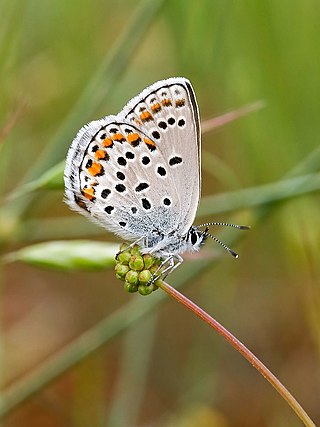
Lathyrus pratensis or meadow vetchling, yellow pea, meadow pea and meadow pea-vine, is a perennial legume that grows to 1.2 m in height.

Leptidea sinapis, or the wood white butterfly of the family Pieridae, is a small white butterfly that is mainly found in England, Ireland, and Northern Europe. The butterfly has white wings with grey or yellow markings near the center or tip of the wing. It flies slowly and low over its shrubbery habitat. Males initiate courtship with females and can mate multiply, while females tend to only mate once in their lifetime.

The green hairstreak is a small butterfly in the family Lycaenidae.

Callistege mi, the Mother Shipton moth, is a moth of the family Erebidae. It was classified by Carl Alexander Clerck in 1759, and is also known under the name of Euclidia mi. In Finnish it is known as piirtoyökkönen and in German as Scheck-Tageule.

The burnet companion moth is a moth of the family Erebidae. It is found in most of the Palearctic realm, from Ireland in the west to Mongolia and Siberia in the east and south to the Mediterranean and North Africa.

Leptidea is a genus of butterflies of family Pieridae, the whites and yellows. They live in Europe and Asia.

Friedrich Joseph Adalbert Seitz, was a German physician and entomologist who specialised in Lepidoptera. He was a director of the Frankfurt zoo from 1893 to 1908 and is best known for editing the multivolume reference on the butterflies and larger moths of the world Die Gross-Schmetterlinge der Erde which continued after his death.

Lygephila pastinum, the blackneck, is a moth of the family Erebidae. The species was first described by Georg Friedrich Treitschke in 1826. It is found in Europe and across the Palearctic Siberia, the Russian Far East, Japan and China.

Boloria titania, the Titania's fritillary or purple bog fritillary, is a butterfly of the subfamily Heliconiinae of the family Nymphalidae.

Glaucopsyche alexis, the green-underside blue, is a butterfly of the family Lycaenidae. It is found in the Palearctic.

Polyommatus amandus, the Amanda's blue, is a butterfly of the family Lycaenidae. It is found in the Palearctic realm.

Euxoa cursoria, the coast dart, is a moth of the family Noctuidae. It is found in northern and central Europe as well as the coastal regions of the British Isles, central Siberia, Mongolia, Tibet and Afghanistan. The subspecies Euxoa cursoria wirima is found in Canada.

Lygephila craccae, the scarce blackneck, is a moth of the family Erebidae. It is found in temperate Europe and across the Palearctic to the Altai Mountains, Korea, Japan and China.

Leptidea amurensis is a butterfly of the family Pieridae. It is found from western Siberia to the Ussuri region and in North Korea, China, Mongolia and Japan.

Ripart's anomalous blue is a butterfly in the family Lycaenidae.

Hyponephele lupina, the Oriental meadow brown or branded meadowbrown, is a butterfly of the family Nymphalidae. It is found in North Africa, south western Europe, southern Russia, Asia Minor, southern Siberia, Middle Asia, Iran and from Baluchistan to Nepal.Seitz describes it thus- lupinus Costa is rather considerably larger than the forms [of Epinepele] so far named; the rusty yellow on the underside of the forewing is brighter, the underside of the hindwing strongly speckled. Southern Italy, Greece.

Polyommatus admetus, the anomalous blue, is a butterfly of the family Lycaenidae. It was described by Eugenius Johann Christoph Esper in 1783. It is found in south-eastern Europe and Turkey.

Kretania sephirus, previously known as Plebejus sephirus, is a species of butterfly that belongs to the family Lycaenidae. It is found in Eastern Europe, the Caucasus, and Asia Minor. The species is part of a species complex, with many members of the complex using variations of the name zephyr blue, including pylaon, trappi, and hesperica. The species, which previously belonged to the genus Plebejus, was moved to the genus Kretania following a 2013 molecular phylogenetics study of the subtribe Polyommatina. Many sephirus populations are threatened, and are legally protected in some countries, such as Hungary.

Neolysandra coelestina is a butterfly found in the Palearctic that belongs to the blues family.

Leptidea duponcheli, the Eastern wood white, is a butterfly found in the Palearctic that belongs to the whites family.






















